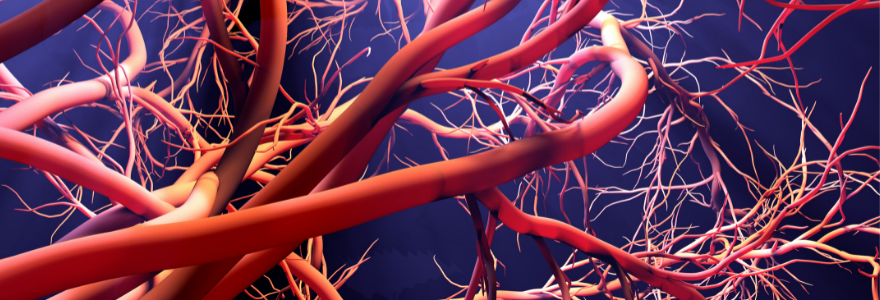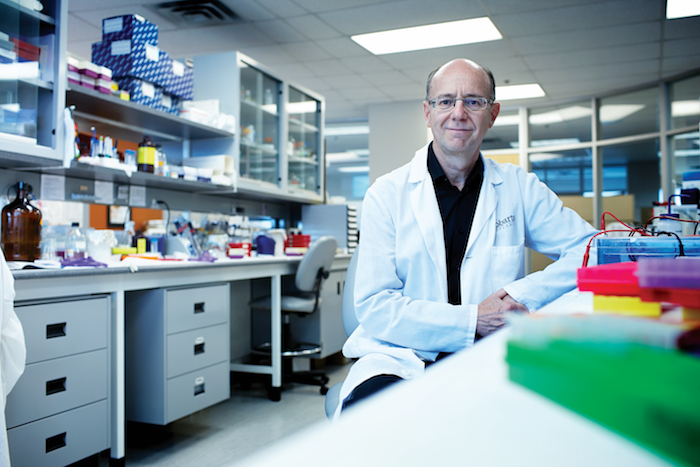Feature: Splitting or sprouting? Researchers shed new light on blood vessel regeneration
 by Max Martin, MMJC'19
by Max Martin, MMJC'19
A novel study by Schulich Medicine & Dentistry researchers is shedding new light on how damaged blood vessels regenerate in the lower limbs.
Findings from Dr. Geoffrey Pickering, a professor of cardiology and scientist at Robarts Research Institute, examining damaged or compromised blood vessels in the legs and lower limbs of mice was recently published in Science Advances.
The research challenges the conventional notion of blood vessels regenerating by a process of sprouting new ones.
Pickering’s findings show damaged blood vessels in the lower limbs regenerate by splitting, not sprouting, and offers new insight into the mechanisms behind the process.
The insights could lead to improvements in patient outcomes for those with vascular diseases or damaged blood vessels, as researchers and clinicians could now begin exploring how to promote this type of splitting activity in the body through various interventions.
While he acknowledged there have been meaningful advances in treating blood vessel issues caused by heart disease or stroke, there’s been a slower pace of advancement for some “tough problems” in the legs.
“Vascular disease has the potential to adversely impact so many organs in the body,” Pickering explained. “In all vascular disease, there’s been this hope in the past few decades that we can capitalize on the fact that, to some degree, blood vessels can regenerate.”
While larger blood vessels that come off of the heart or other major organs can’t regenerate, smaller ones can. One tissue where that’s very clear is in the larger leg muscles.

“The question becomes what can we do from a medical standpoint to stimulate the growth and regeneration of healthy new blood vessels,” Pickering said.
The widely accepted mechanism in which blood vessels reform is through a process referred to as sprouting.
Pickering says to think of blood vessels like a tree – there’s a larger trunk, with the major blood vessels, and then large branches that eventually sprout off smaller branches and twigs. Break off a small twig, and it can eventually grow back.
But many therapies designed to stimulate the sprouting of new blood vessels haven’t worked in the legs or heart; a sign the conventional sprouting process might not be as active in those parts of the body.
While big blood vessels can be observed, it’s not quite as simple at the micro level with tiny blood vessels.
By using advanced, microscopic imaging techniques to watch and record blood vessels and blood flow in the skeletal muscles of mice, Pickering’s team was able to get a better understanding of exactly how new blood vessels form.
“Our primary finding was this notion of tree branch sprouting has very rare occurrence,” Pickering explained. “The blood vessel network reforms and damaged muscles will in fact regenerate, but for the life of us, we could hardly find evidence of these tree vessel sprouts.”
Instead, Pickering observed a much different mechanism to form new blood vessels: splitting.
In mice with an injured leg, small blood vessels initially disappear along with the muscle dying itself. But when they regenerate a few days later, they return as “a primitive channel, a kind of tube with a sluggish flow of blood gurgling down it,” Pickering said.
“That sluggish flow channel was not going to do much good, it can’t supply blood without a tree-like network,” he added.
The team observed that a newly forming blood vessel undergoes a process of splitting itself, and then splitting itself again, to replicate and create a network of blood vessels.
While Pickering’s lab wasn’t the first to discover the process of splitting, their work, in addition to the discoveries in regenerating muscle, has revealed new insights into the mechanisms behind the splitting process.
“One or more of the cells that line the inside of the blood vessel has to somehow dive into the inside of that flowing channel, and somehow cross from one side to another like you might bridge across a river,” Pickering explained.
Eventually, a number of “bridges” form and split the vessel in two.
To further study how cells in the lining of blood vessels cross the channel, Pickering’s team collaborated with other researchers at Western to bioengineer micro-fluidic tubes that could mimic the blood flow in early blood vessels.
“We developed strategies to line those tubes with the same type of cells that line our own vessels,” he explained. “For the first time, we were able to identify a lining cell move from its position lining the wall of the vessel, to being inside the vessel and crossing from one side to another.”
Pickering said this discovery opens the door to further dissect the reasons why this might be happening.
His hypothesis is that the cells acknowledge the early formed blood vessels with poor, sluggish flow aren’t effective and seek to improve the situation.
“Under these very primitive conditions, when the flow is burbling way slower than a blood vessel would like, cells think, ‘I’m not happy, I need to change this situation,’ and begin separating the vessel until the flow speeds up.”
To build on the findings, Pickering said researchers can now look for ways to enhance blood vessel splitting and regeneration, which could lead to improved patient outcomes.
“Those are the mechanistic pieces that we are arguing we really need to think about to reconsider how new blood vessels grow in an adult, particularly in cases where the tissue itself needs to be regenerated,” he said.








